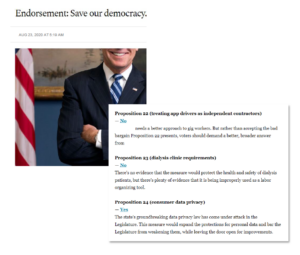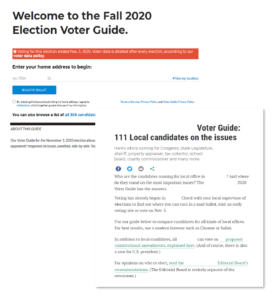By Matt Lindsay, CEO and President and Mather Economics
August 12, 2024
Elections aren’t just a test of democracy—they’re the ultimate stage where news media can prove their worth, guiding the public through the noise to the heart of the truth. Beyond fulfilling their journalistic mission, elections present a strategic business opportunity for publishers. The increase in readership during election periods allows for deeper audience engagement, expanded reach, and content monetization opportunities. To maximize these benefits, it’s crucial for publishers to approach their election coverage strategically.
Learning from the Past for Future Success
The 2020 U.S. presidential election revealed several insights that remain relevant today and can guide publishers in 2024. While the timing can vary by season and locality, most publishers begin offering election-related content in June. Mather’s 2020 benchmarks (see Chart 1) show that election content production increases throughout the season, peaking at around 14% of total articles in November. Similarly, article page views during this period represented 21% of total page views.
Interestingly, the proportion of election content leading to conversions more than tripled from September to October in 2020, rising from 6% to 19%. This indicates that election content has an outsized impact on the path to conversion versus article page views in most months, making this timeframe ideal for marketing this content and delivering personalized subscription offers to this audience. To optimize results, newsrooms should strategically align their election content supply with anticipated demand, especially during the final two months of the season when engagement and conversions peak.

Optimizing Your Election Coverage Strategy
In this section, we’ll explore key focus areas to refine your election strategy. Concentrating on these elements will help you elevate your coverage and enhance your ability to engage, retain, and convert audiences during this critical period.
- Define the Scope of Coverage
- Outline Coverage in Advance: Begin by defining the scope of your election coverage early. This will allow for adequate resource allocation, sufficient development time, and the creation of an optimal publication schedule.
- Cohesive Newsroom Operation: Ensure that the newsroom operates cohesively, with coverage driven by both data-driven insights and editorial expertise.
- Focus on Unique Content: While syndicated content can help fill gaps, prioritize producing unique, locally relevant content, as it tends to be more valued by readers.
- Determine Content Access Levels
- Open vs. Premium Content: Decide which content will be freely accessible and which will be behind a paywall. This strategic distinction will help you balance audience reach and subscription growth.
- Enhance the User Experience
- Centralized Election Coverage: Create a dedicated section on your site for election content to streamline discovery and engagement.
- Integrate High-Impact Features: Incorporate features such as voter guides and endorsements into these specialized pages to add value and drive engagement.
- Robust Recirculation Strategy: Implement a strong recirculation strategy to encourage users to explore additional content, increasing overall site engagement and improving subscriber retention.
- Implement an Effective Marketing Strategy
- Communicate the Value of Coverage: Highlight the importance and value of your election coverage across various channels throughout the election cycle.
- Targeted Communication Series: Develop a targeted communication series that includes welcome messages, soft-modaling, and email updates. These efforts will guide readers in accessing and navigating your election content.
- Reinforce Credibility and Diversity: Continuously emphasize your commitment to providing diverse and credible content that empowers readers to make informed decisions.
Maximizing the Value of Election Content
Not all election content is created equal. Mather’s 2020 analysis examined specialty formats such as Endorsements, Voter Guides, and Election Results, comparing their impact on production, engagement, and conversion with overall election coverage.
Key Insights:
- Endorsements: While these do not tend to reach as wide of an audience as other election content, they are highly valued by core users who are more likely to subscribe (24% of Path to Conversion – Nov. ‘20).
- Voter Guides: As expected, this content is fairly limited in terms of production but exhibits a strong path to conversion performance for its size (8% of PTC from 1% of total articles – Nov. ‘20), making it an efficient avenue for engaging and converting users.
- Results: Our 2020 analysis shows that while this content format attracts a broad audience and constitutes a significant portion of content production as the season wraps up (1.3% of articles published – Nov. ‘20), it does not drive conversions as effectively.
Below, we’ll outline best practices for each specialty content area, offering recommendations to help you refine your strategy, deliver greater value to your readers, and maximize your return on investment.

Endorsement Pages
To create high-impact endorsement pages, it’s essential to deliver comprehensive editorials on candidates and provide clear ballot recommendations while ensuring trust and transparency for potential subscribers. Centralize all endorsements on a single page, where you clearly state your publisher’s position and offer key takeaways that support each recommendation. Additionally, present the effects of both local and national policies and candidates in straightforward, accessible language to make your content easily understandable and engaging for readers.

Voter Guides
Top-performing voter guides include simplified ballot summaries, side-by-side candidate profiles, and personalized planning features. Ensure these guides are easily accessible from the homepage and promoted on election-related pages, offering comprehensive access to ballot measure summaries and voting FAQs from one central location. Consider incorporating interactive tools such as “Build My Ballot,” which will engage readers directly with the content and empower them to make decisions based on tailored information and functionality.

Election Results
Election results pages tend to attract a wider audience. To capture and retain reader interest, these pages should be visually engaging and interactive, with minimal text.

Create a unified results page that features national, state, and local results, using frequently updated visualizations to present information in a clear and simplified format. Enhance user experience with high-level summaries and interactive elements like live maps and charts, allowing readers to drill down into the results that matter most to them.
Closing thoughts
As the 2024 election season unfolds, seize the opportunity to refine your coverage and strategies for elections and other major news events. By applying insights from past cycles and focusing on key areas—such as optimizing your content mix, enhancing user experience, and implementing targeted marketing—you can effectively engage and convert your audience.
To dive deeper into insights from the 2020 election cycle, access our full report on below:
Read more insights




